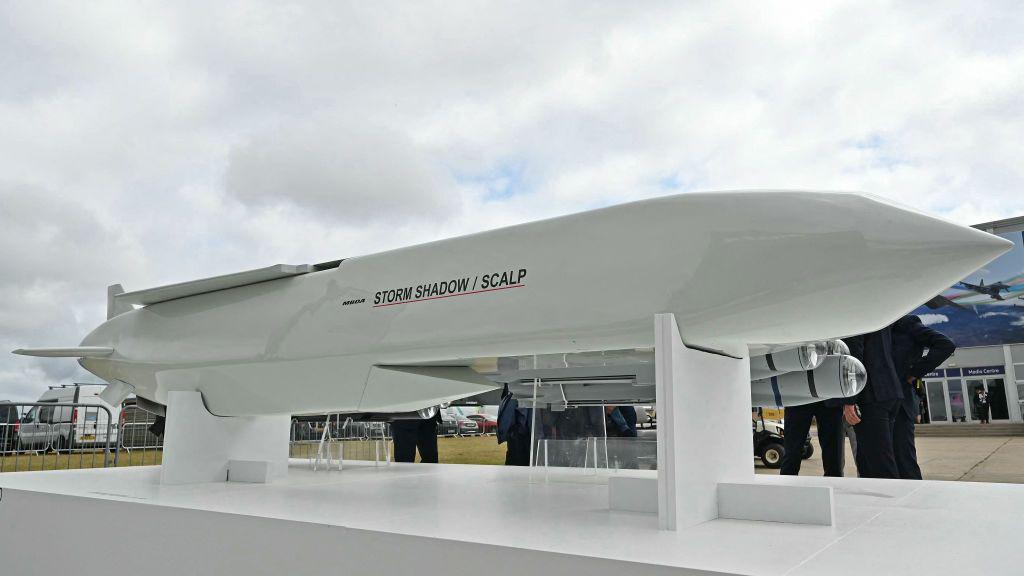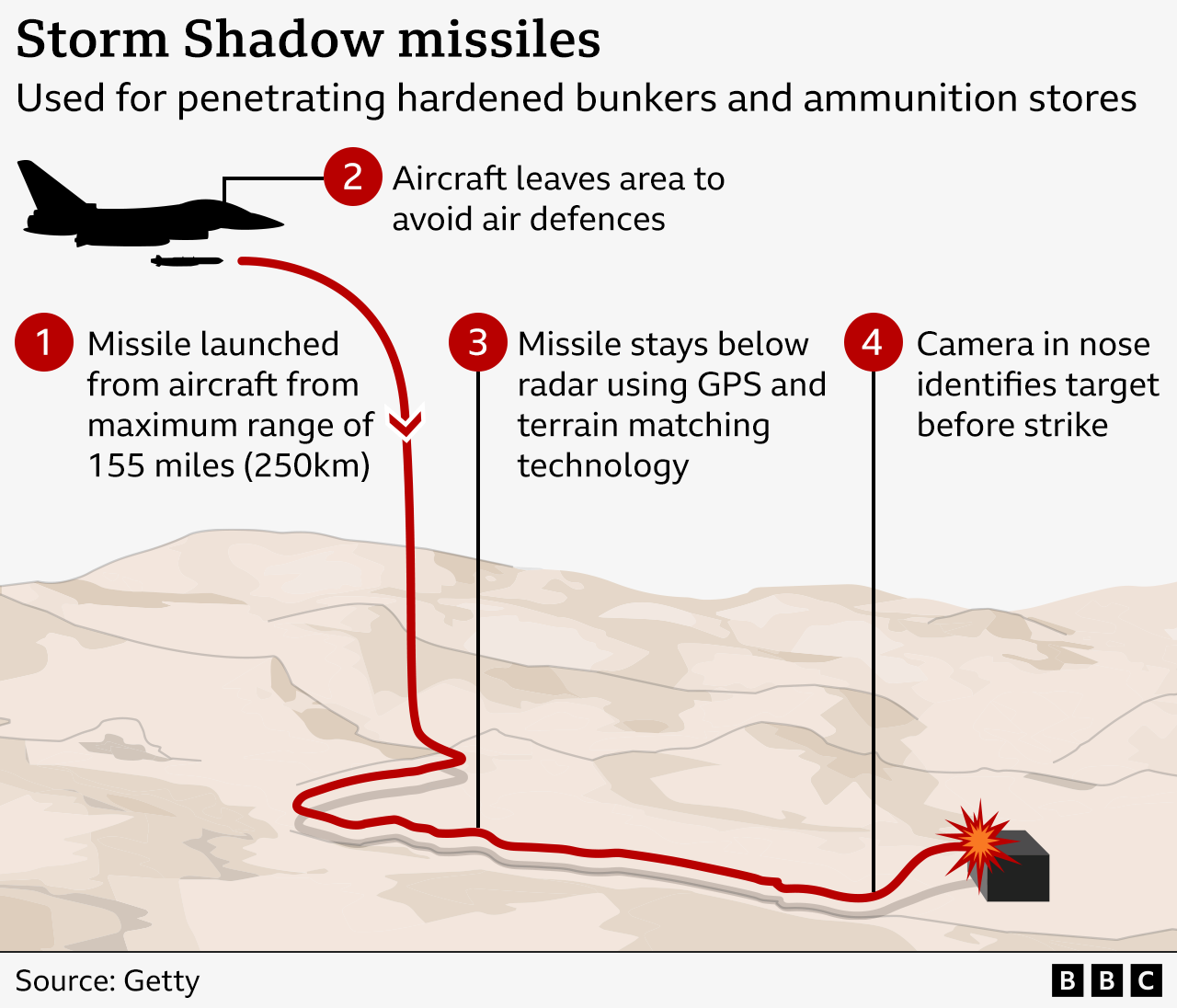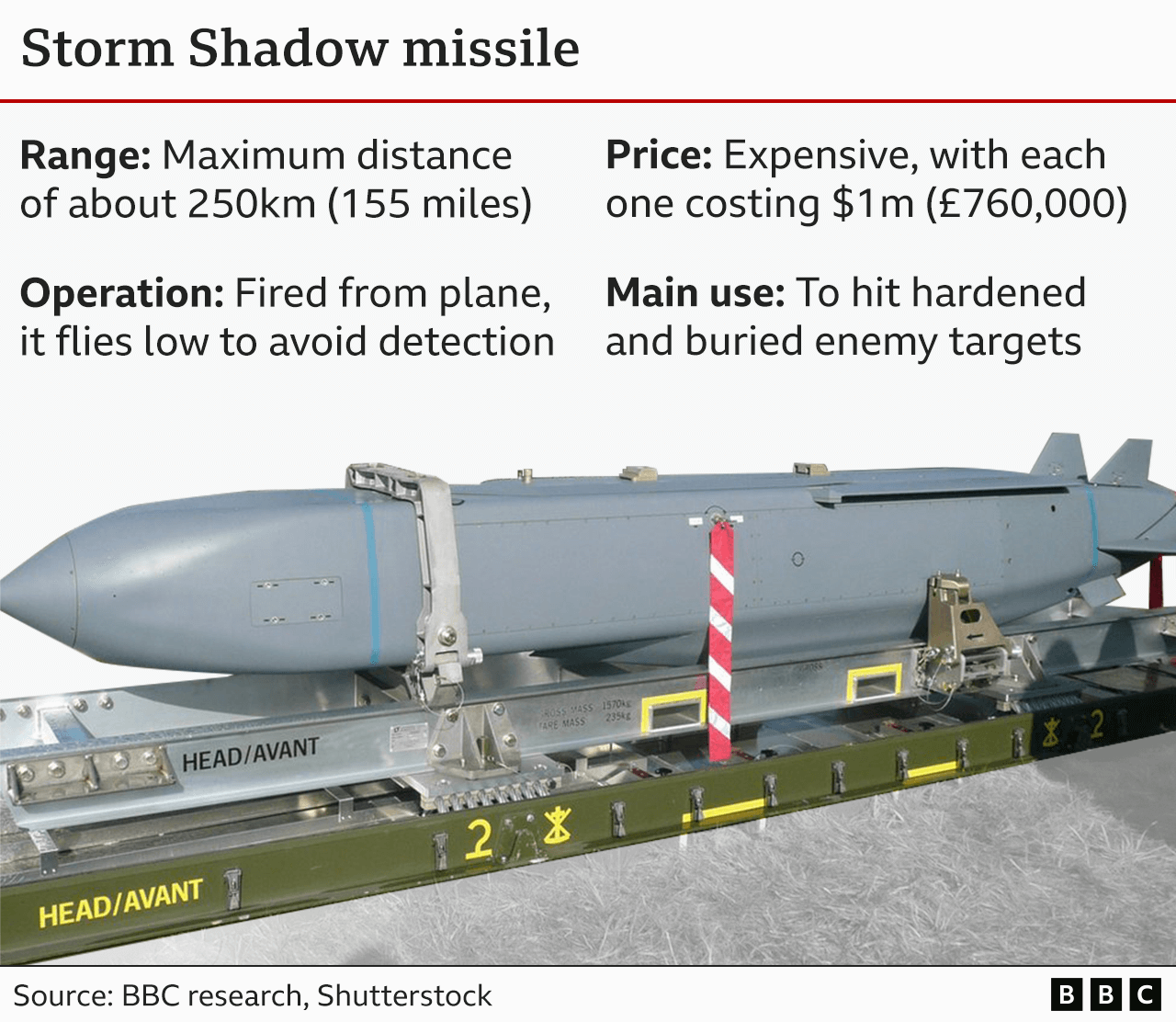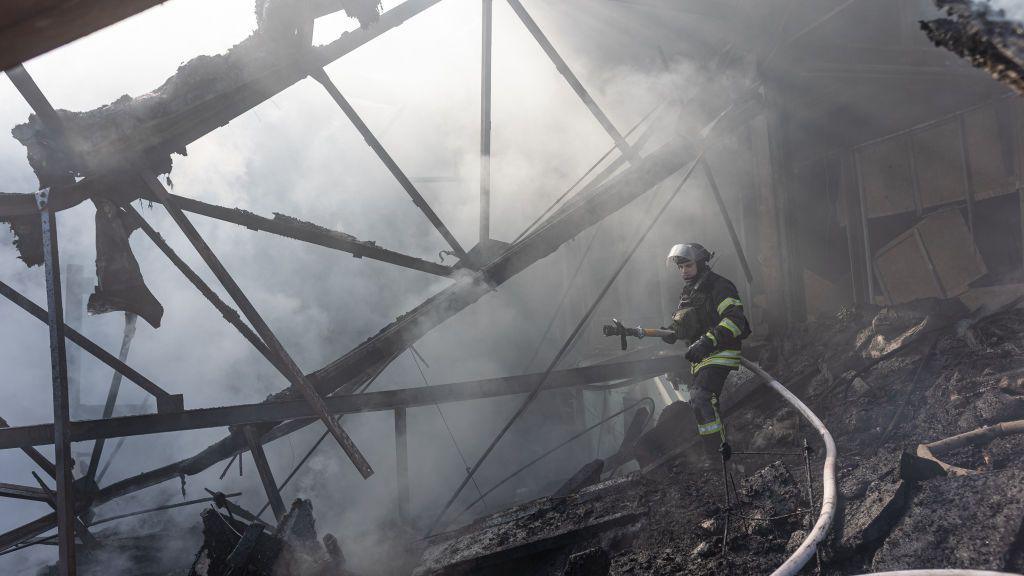What are the Storm Shadow missiles Ukraine has fired into Russia?

The UK has supplied Storm Shadow long-range missiles to Ukraine after a request from Kyiv for its fight against invading Russian forces
- Published
Ukraine has used longer-range Storm Shadow missiles against targets inside Russia for the first time, the BBC understands.
The move follows US President Joe Biden giving Ukraine the green light to use Atacms missiles supplied by Washington to strike inside Russia, prompting a furious response from the Kremlin.
Ukraine had been using both missiles for months, but only against targets in territory occupied by Russia.
What is Storm Shadow?
Storm Shadow is an Anglo-French cruise missile with a maximum range of around 250km (155 miles). The French call it Scalp.
It is launched from an aircraft, then flies at close to the speed of sound, hugging the terrain, before dropping down and detonating its high explosive warhead.
Storm Shadow - made by manufacturer MBDA - is considered an ideal weapon for penetrating hardened bunkers and ammunition stores, such as those used by Russia in its war against Ukraine.

But each missile costs nearly US$1m (£767,000), so they tend only to be launched as part of a carefully planned flurry of much cheaper drones, sent ahead to confuse and exhaust the enemy’s air defences, just as Russia does to Ukraine.
They have been used with great effect, hitting Russia’s Black Sea naval headquarters at Sevastopol and making the whole of Crimea unsafe for the Russian navy.
Justin Crump, a military analyst, former British Army officer and CEO of the Sibylline consultancy, says Storm Shadow has been a highly effective weapon for Ukraine, striking precisely against well protected targets in occupied territory.
"It’s no surprise that Kyiv has lobbied for its use inside Russia, particularly to target airfields being used to mount the glide bomb attacks that have recently hindered Ukrainian front-line efforts," he says.

Has the UK changed Storm Shadow rules?
The UK has supplied Storm Shadow missiles to Ukraine for months but, like the US, had not allowed Kyiv to use them to strike inside Russia.
But this changed after the Biden administration updated its rules, allowing comparable Atacms missiles to be used outside of Ukraine's borders.
On Wednesday, it was confirmed Ukraine used UK-supplied Storm Shadow missiles against targets inside Russia for the first time.
The Ministry of Defence has not yet publicly commented. But the UK government was known to have been supportive of allowing Ukraine more freedom to use missiles as it saw fit, although it had followed US policy.
Why does Ukraine want Storm Shadow?
Ukraine hopes the use of longer-range missiles inside Russia will help it defend the small chunk of Russian territory it currently occupies in the Kursk region. A major assault by Russian and Northern Korean troops is expected.
But Ukrainian cities and front lines are also under daily bombardment from Russia.
Many of the missiles and glide bombs that wreak devastation on military positions, blocks of flats and hospitals are launched by Russian aircraft far within Russia itself.
Kyiv has said that not being allowed to hit the bases these attacks were launched from was akin to making it fight this war with one arm tied behind its back.
With the green light to use Storm Shadow and Atacms missiles, airfields and key logistics hubs deep inside Russia have come within Ukraine’s range.

Ukraine is under daily bombardment
Ukraine does have its own, innovative and effective long-range drone programme.
At times, these drone strikes have caught the Russians off guard and reached hundreds of kilometres inside Russia.
But they can only carry a small payload and most get detected and intercepted.
How much difference could Storm Shadow make?
Kyiv has been asking to use long-range Western missiles inside Russia for so long that Moscow has already taken precautions.
It has moved bombers, missiles and some of the infrastructure that maintains them further back, away from the border with Ukraine and beyond the range of Storm Shadow.
There is scepticism among Western officials that Storm Shadow and the American Atacms will be decisive.
However, the Institute for the Study of War think tank (ISW) has identified around 225 Russian bases that would be in range of Storm Shadows fired from Ukraine.
And Sibylline's Justin Crump says that while Russian air defences have evolved to counter the threat of Storm Shadow within Ukraine, this task will be much harder given the scope of Moscow’s territory that could now be exposed to attack.
"This will make military logistics, command and control, and air support harder to deliver, and even if Russian aircraft pull back further from Ukraine’s frontiers to avoid the missile threat they will still suffer an increase in the time and costs per sortie to the front line."
Matthew Savill, director of military science at the Rusi think tank, believes it could also pose a dilemma for Russia as to where to position air defences, which could make it easier for Ukraine’s drones to get through.
Ultimately though, says Savill, Storm Shadow is unlikely to turn the tide. Ukraine doesn't have many missiles, and the UK has very few left to give.

US President Joe Biden and Ukraine's Volodymyr Zelensky addressed a recent Nato summit in Washington
What has Putin said about Storm Shadow?
One reason President Putin views the use of Storm Shadow as an escalation is his belief that Ukrainian troops cannot use long-range missile systems without the aid of Western specialists.
He previously told reporters in Russia that "only servicemen of Nato countries can input flight missions into these missile systems," adding that Kyiv also relies on satellite intelligence supplied by the West to choose targets.
Manufacturer MBDA declined to comment on the claims when approached by the BBC, directing queries to the UK Ministry of Defence.
A spokesperson for Ukraine's presidential office also declined to address Putin's allegations, saying they could not comment on "special technical details regarding weapons".
Justin Crump cast doubt on Putin's claim, telling the BBC that if "that claim were true, then Russia would have made it more clearly when the weapons were first supplied, and when they conducted successful and impactful operations against for example the Black Sea Fleet HQ in occupied Crimea".
"The missile is available for export sales; is Russia seriously saying that any buyer would have to have a Nato/UK team to program and use the missile? That must presumably be buried deep in the fine print of the brochure, and wouldn't make it an appealing prospect," he noted.